The Baylor University Clinical Trial
From the time we first released X-Factor back in 2003, it was our ultimate goal to legitimize this powerful anabolic in the world of sports medicine. In order to be accepted here, a product must prove itself, not merely in anecdotal reports from users, but in published peer-reviewed clinical studies. Few sports supplements are ever put through the rigorous evaluation of an independent double blind University investigation, and fewer still have demonstrated true ergogenic benefits under the rigid standards of statistical analysis and scientific reproducibility. It is in the annals of respected Sports Medicine journals that a supplement’s true worth will shine through, or its deficiencies made clear.
Last year we put our product to the ultimate test, asking the Exercise & Sport Nutrition Laboratory at Baylor University to conduct one of the single most comprehensive investigations ever conducted on a sports nutrition product. The results were presented at the International Society of Sports Nutrition conference in June 2006, and represent a great success in demonstrating, in a clinical setting, the ergogenic potential of arachidonic acid. The data underlines the countless reports of increased muscle mass, strength, endurance and fat loss coming from competitive athletes and bodybuilders worldwide, and earns arachidonic acid a place next to a very select few clinically proven ergogenic nutrients.
Overview
The purpose of this double-blind placebo-controlled study was to determine if 50 days of resistance training and arachidonic acid (X-Factor™) supplementation would affect training adaptations in experienced (>1 year) resistance-trained males.
Protocol
Thirty-one subjects (22.1 ± 5.0 yrs) were randomly assigned to ingest either a placebo (n=16) or arachidonic acid [X-Factor] (n=15). All subjects ingested a total of four capsules each day by ingesting one 250mg capsule every four hours. Supplemental protein powder was provided in order attain a protein intake of 2 grams per kilogram of bodyweight per day. Each subject completed two upper-body and two lower-body workouts each week in a split-body fashion. Total training volumes were calculated from training logs. Body mass, body composition using DEXA, bench press one-repetition maximum (1RM), leg press 1RM and Wingate anaerobic capacity tests were completed at 0, 25 and 50 days. Data were analyzed using repeated measures ANOVA and are presented as mean ± SD changes from baseline after 50-days. Strength Results
Strength Results
Bench Press 1-Rep Max
During the clinical study, subjects taking X-Factor added an average of 25lbs to their bench press maximum weight in 50 days. This increase was nearly 45% greater than that noted in the exercise-only (placebo) group. Several subjects gained more than 50 lbs on their bench press 1-rep max over the 50-day period!
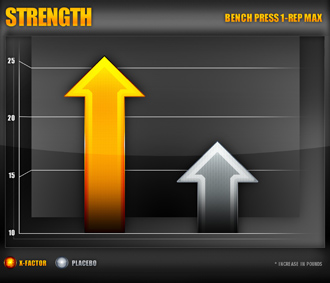
Muscular Power Results
Average Power
In the standard Wingate cycle ergometer test often used by professional athletes to measure anaerobic power and performance, the X-Factor group outperformed the placebo group on Average Power by an amazing 21 watts (AA: 37.9W P: 17.0W). That's a net increase of nearly 225% compared to placebo!
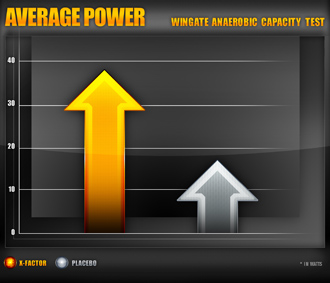
Wingate Peak Power Test
Using the standard Wingate cycle ergometer test to measure relative peak anaerobic power, subjects taking X-Factor increased leg power by 1.2 Watts•kg-1. This represents a net increase of more than 600% over the placebo group (-.2 Watts•kg-1).
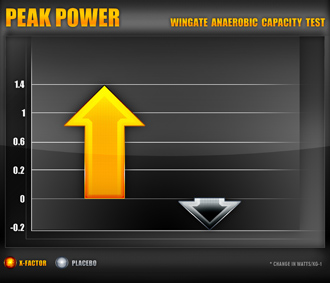
Muscular Endurance Results
Total Work
Total Work, as recorded in the standard energy unit Joules, increased by 1,292J in the group taking X-Factor, while Total Work increased 510J in the placebo group. This is more than a 250% increase compared to placebo! This means more sets, more reps, and far more total workload capacity for those taking X-Factor!
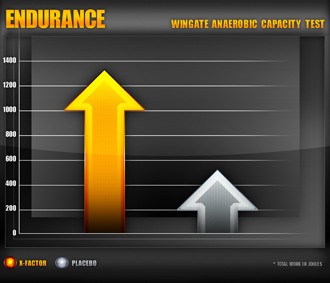
Safety Results
Clinical Markers of Safety
No changes were noted in immune and serum clinical safety markers in subjects taking X-Factor. This included immune markers (white blood cell count, neutrophil count, lymphocyte count, and neutrophil: lymphocyte ratio), red blood cell count, hemoglobin concentration, hematocrit, liver enzymes (alanine aminotransferase, gamma-glutamyl transferase, serum albumin, and aspartate aminotransferase), and kidney function/catabolic indicators (blood urea nitrogen, creatinine, and BUN:creatinine ratio). The results demonstrated that X-Factor supplementation during an extended period of resistance training is physiologically well tolerated and does not alter whole blood, liver or kidney clinical safety markers.
Clinical Marker of Inflammation
The X-Factor group noted a significant decrease in serum levels of Interkeukin-6 (IL-6), a primary regulator and marker of inflammation in the body (AA: -28.8 P: 52.5). In addition to being “pro-inflammatory”, Interleukin-6 (IL-6) is the primary stimulus for the hepatic production of C-reactive protein, and is associated with a number of adverse health conditions including cardiovascular disease, diabetes, autoimmune disorder, rheumatoid arthritis, asthma, osteoporosis, and cancer.
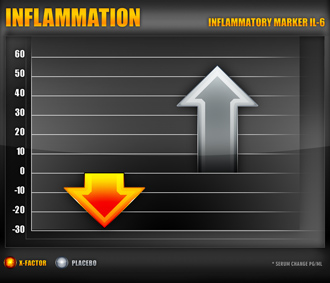
X-Factor is SAFE
X-Factor supplementation during 50 days of resistance training did not negatively affect markers of immune function, inflammation, or general health and safety. Reductions in Interleukin-6 suggest it might, furthermore, offer a health-protective benefit by reducing systemic inflammation.
From the time we first released X-Factor back in 2003, it was our ultimate goal to legitimize this powerful anabolic in the world of sports medicine. In order to be accepted here, a product must prove itself, not merely in anecdotal reports from users, but in published peer-reviewed clinical studies. Few sports supplements are ever put through the rigorous evaluation of an independent double blind University investigation, and fewer still have demonstrated true ergogenic benefits under the rigid standards of statistical analysis and scientific reproducibility. It is in the annals of respected Sports Medicine journals that a supplement’s true worth will shine through, or its deficiencies made clear.
Last year we put our product to the ultimate test, asking the Exercise & Sport Nutrition Laboratory at Baylor University to conduct one of the single most comprehensive investigations ever conducted on a sports nutrition product. The results were presented at the International Society of Sports Nutrition conference in June 2006, and represent a great success in demonstrating, in a clinical setting, the ergogenic potential of arachidonic acid. The data underlines the countless reports of increased muscle mass, strength, endurance and fat loss coming from competitive athletes and bodybuilders worldwide, and earns arachidonic acid a place next to a very select few clinically proven ergogenic nutrients.
Overview
The purpose of this double-blind placebo-controlled study was to determine if 50 days of resistance training and arachidonic acid (X-Factor™) supplementation would affect training adaptations in experienced (>1 year) resistance-trained males.
Protocol
Thirty-one subjects (22.1 ± 5.0 yrs) were randomly assigned to ingest either a placebo (n=16) or arachidonic acid [X-Factor] (n=15). All subjects ingested a total of four capsules each day by ingesting one 250mg capsule every four hours. Supplemental protein powder was provided in order attain a protein intake of 2 grams per kilogram of bodyweight per day. Each subject completed two upper-body and two lower-body workouts each week in a split-body fashion. Total training volumes were calculated from training logs. Body mass, body composition using DEXA, bench press one-repetition maximum (1RM), leg press 1RM and Wingate anaerobic capacity tests were completed at 0, 25 and 50 days. Data were analyzed using repeated measures ANOVA and are presented as mean ± SD changes from baseline after 50-days. Strength Results
Strength Results
Bench Press 1-Rep Max
During the clinical study, subjects taking X-Factor added an average of 25lbs to their bench press maximum weight in 50 days. This increase was nearly 45% greater than that noted in the exercise-only (placebo) group. Several subjects gained more than 50 lbs on their bench press 1-rep max over the 50-day period!

Muscular Power Results
Average Power
In the standard Wingate cycle ergometer test often used by professional athletes to measure anaerobic power and performance, the X-Factor group outperformed the placebo group on Average Power by an amazing 21 watts (AA: 37.9W P: 17.0W). That's a net increase of nearly 225% compared to placebo!

Wingate Peak Power Test
Using the standard Wingate cycle ergometer test to measure relative peak anaerobic power, subjects taking X-Factor increased leg power by 1.2 Watts•kg-1. This represents a net increase of more than 600% over the placebo group (-.2 Watts•kg-1).

Muscular Endurance Results
Total Work
Total Work, as recorded in the standard energy unit Joules, increased by 1,292J in the group taking X-Factor, while Total Work increased 510J in the placebo group. This is more than a 250% increase compared to placebo! This means more sets, more reps, and far more total workload capacity for those taking X-Factor!

Safety Results
Clinical Markers of Safety
No changes were noted in immune and serum clinical safety markers in subjects taking X-Factor. This included immune markers (white blood cell count, neutrophil count, lymphocyte count, and neutrophil: lymphocyte ratio), red blood cell count, hemoglobin concentration, hematocrit, liver enzymes (alanine aminotransferase, gamma-glutamyl transferase, serum albumin, and aspartate aminotransferase), and kidney function/catabolic indicators (blood urea nitrogen, creatinine, and BUN:creatinine ratio). The results demonstrated that X-Factor supplementation during an extended period of resistance training is physiologically well tolerated and does not alter whole blood, liver or kidney clinical safety markers.
Clinical Marker of Inflammation
The X-Factor group noted a significant decrease in serum levels of Interkeukin-6 (IL-6), a primary regulator and marker of inflammation in the body (AA: -28.8 P: 52.5). In addition to being “pro-inflammatory”, Interleukin-6 (IL-6) is the primary stimulus for the hepatic production of C-reactive protein, and is associated with a number of adverse health conditions including cardiovascular disease, diabetes, autoimmune disorder, rheumatoid arthritis, asthma, osteoporosis, and cancer.

X-Factor is SAFE
X-Factor supplementation during 50 days of resistance training did not negatively affect markers of immune function, inflammation, or general health and safety. Reductions in Interleukin-6 suggest it might, furthermore, offer a health-protective benefit by reducing systemic inflammation.
Performance and body composition changes after 50 days of concomitant arachidonic acid supplementation and resistance training.
M Iosia, M Roberts, C Kerksick, B Campbell, T Harvey, C Wilborn, R Wilson, M. Greenwood, D Willoughby and R Kreider. Exercise & Sport Nutrition Laboratory, Center for Exercise, Nutrition & Preventive Health Research, Baylor University, Waco, TX 76798-7313. Mike_Iosia@baylor.edu.
ABSTRACT 1
Arachidonic acid (AA) is a polyunsaturated omega-6 (0-6) fatty acid that is stored within skeletal muscle phospholipids and has been purported to stimulate changes in strength and body composition while resistance training. The purpose of this study was to determine if 50 days of concomitant resistance training and AA supplementation affects performance and/or body composition adaptations in previously resistance-trained males. Thirty-one subjects (22.1 ± 5.0 yrs, 178.9 ± 3.4 cm, 86.1 ± 13.0 kg, 18.1 ± 6.4 % body fat) were randomly assigned to ingest either a corn oil placebo (P: n=16) or AA (n=15). All subjects ingested a total of four capsules each day by ingesting one 0.25 gram capsule every four hours for a total daily dose of 1 gram•d-1 and were given a supplemental protein powder in order attain a protein intake of 2 g•kg-1•d-1. Each subject completed two upper-body and two lower-body workouts each week in a split-body fashion. Total training volumes were calculated from training logs. Body mass, body composition using DEXA, bench press one-repetition maximum (1RM), leg press 1RM and Wingate anaerobic capacity tests were completed at 0, 25 and 50 days. Data were analyzed using repeated measures ANOVA and are presented as mean ± SD changes from baseline after 50-days. No significant differences (p>0.05) between groups were noted for training volume. Training significantly increased body mass (p<0.01), DEXA lean mass (p<0.001), bench press 1RM (p<0.001), leg press 1RM (p<0.001), Wingate average power (p<0.001) and Wingate total work (p<0.001) indicating that the subjects experienced positive training adaptations. No significant group x time interaction effects were observed among groups in changes in body mass (AA: 1.6 ± 2.3; P: 1.0 ± 2.1 kg, p=0.45), DEXA lean mass (AA: 1.2 ± 1.6; P: 1.0 ± 1.9 kg, p=0.71), or leg press 1RM (AA: 25.0 ± 24.7; P: 22.7 ± 34.0 kg, p=0.83). Statistical trends were seen in bench press 1RM (AA: 11.0 ± 6.2; P: 8.0 ± 8.0 kg, p=0.20), Wingate average power (AA: 37.9 ± 10.0; P: 17.0 ± 24.0 W, p=0.16), and Wingate total work (AA: 1292 ± 1206; P: 510 ± 1249 J, p=0.087). A significant group x time interaction effect was observed in Wingate relative peak power (AA: 1.2 ± 0.5; P: -0.2 ± 0.2 W•kg-1, p=0.015). In conclusion, AA supplementation during resistance-training promoted significant increases in relative peak power with other performance related variables approaching significance. These findings provide some preliminary evidence to support the use of AA as an ergogenic aid. More research is needed to explore the effects of AA supplementation on training adaptations.
Proceedings of the International Society of Sports Nutrition (ISSN) Conference June 15-17, 2006.
Hormonal and intramuscular adaptations over 50 days of concomitant arachidonic acid supplementation and resistance training.
Roberts, M, C Kerksick, L Taylor, M Iosia, B Campbell, C Wilborn, T Harvey, R Wilson, M. Greenwood, D Willoughby and R Kreider. Exercise & Sport Nutrition Laboratory, Center for Exercise, Nutrition & Preventive Health Research, Baylor University, Waco, TX 76798-7313. Mike_Roberts@baylor.edu.
ABSTRACT 2
Prostaglandins are derived from dietary arachidonic acid (AA) and up-regulate recovery mechanisms including inflammation and protein synthesis within skeletal muscle in response to resistance training. The purpose of this study was to determine if 50 days of concomitant resistance training and AA supplementation elicited changes in hormonal and/or intramuscular markers in resistance-trained males. Thirty-one subjects (22.1 ± 5.0 yrs, 86.1 ±1 3.0 kg, 178.9 ± 3.4 cm, 18.1 ± 6.4 % body fat) were randomly assigned to a placebo (P: n = 16; 1 g capsulated corn oil/day) or AA group (AA: n = 15; 1 g capsulated AA/day) and were given supplemental protein powder to ingest in order attain an adequate protein intake of 2 g/kg/day while participating in a 4 day/wk resistance training regimen (2 upper/ 2 lower). Fasting blood was taken on days 0, 25 and 50 and muscle biopsies were taken from the vastus lateralis on days 0 and 50. Prostaglandin E2 (PGE2), prostaglandin F2a (PGF2a), interleukin-6 (IL-6), free testosterone (fTEST), total testosterone (tTEST) and cortisol (CORT) were assessed with EIA while myosin heavy chain isoform (MHC I, -IIa, -IIx) and mRNA levels were detected using SDS-PAGE and real-time RT-PCR, respectively. Hormonal and MHC data were analyzed by ANOVA with repeated measures while independent t-tests were used to assess changes in MHC mRNA expression. Data are expressed as means ± SD changes from baseline after 50-days of supplementation for the AA and P groups, respectively. Statistical trends were found for PGE2 increases (98.5 ± 217; P -73.8 ± 273 pg/ml, p=0.063) and IL-6 decrements (-28.8 ± 47; 52.5 ± 45 pg/ml, p=0.067) in the AA group. A non-significant increase in PGF2a was also found in the AA group (AA: 45.2 ± 153; P: -33.6 ± 139 pg/ml, p=0.143). fTEST significantly decreased (p=0.03) in both groups over time with no differences among groups (AA: -2.99 ± 6; P -2.60 ± 8 pg/ml, p=0.88). There was no significant group or main effects for tTEST or CORT. MHC IIa levels significantly increased in both groups over time (p=0.009) with no differences among groups (AA: 120 ± 229; P 139 ± 262 ng/ml, p=0.84). There were no significant time or group x time effects for MHC I or MHC IIx levels. A significant decrement was observed in MHC IIx basal mRNA expression in the AA group (AA: -6.96 ± 24.28; P: -4.97 ± 10.88 %, p=0.02), while there was no significant time or interaction effects for MHC I or IIa expression. Results suggest that AA supplementation during resistance training may exert some potentially favorable alterations in an inflammatory marker, fasting hormonal, and gene expression patterns and that additional research is necessary to further examine this hypothesis.
Proceedings of the International Society of Sports Nutrition (ISSN) Conference June 15-17, 2006.
Changes in whole blood and clinical safety markers over 50 days of concomitant arachidonic acid supplementation and resistance training.
Wilborn, C, M Roberts, C Kerksick, M Iosia, L Taylor, B Campbell, T Harvey, R Wilson, M. Greenwood, D Willoughby and R Kreider. Exercise & Sport Nutrition Laboratory, Center for Exercise, Nutrition & Preventive Health Research, Baylor University, Waco, TX 76798-7313. Colin_Wilborn@baylor.edu.
ABSTRACT 3
Prostaglandins are derived from dietary arachidonic acid (AA) and up-regulate recovery mechanisms including inflammation and protein synthesis within skeletal muscle in response to resistance training. The purpose of this study was to determine if 50 days of concomitant resistance training and AA supplementation elicited changes in immune and serum clinical safety markers in resistance-trained males. Thirty-one subjects (22.1 ± 5.0 yrs, 86.1 ±1 3.0 kg, 178.9 ± 3.4 cm, 18.1 ± 6.4 % body fat) were randomly assigned to a placebo (P: n = 16; 1 g capsulated corn oil/day) or AA group (AA: n = 15; 1 g capsulated AA/day) and were given supplemental protein powder to ingest in order attain an adequate protein intake of 2 g/kg/day while participating in a 4 day/wk resistance training regimen (2 upper/ 2 lower). Fasting blood was taken on days 0, 25 and 50. Immune markers were measured from whole blood using flow cytometric analysis (Abbott Cell Dyne 3500) while serum markers were measured from separated serum using nephelometric analysis (Dade Dimension XRL). Data was analyzed by ANOVA with repeated measures and significant changes (p=0.05) are expressed as means ± SD changes from baseline after 50-days of supplementation for the AA and P groups, respectively. There were no significant group x time interactions in immune markers including white blood cell count (p=0.12), neutrophil count (p=0.17), lymphocyte count (p=0.20) or neutrophil: lymphocyte ratio (p=0.49). There were also no significant group x time interactions with red blood cell count (p=0.49), hemoglobin concentration (p=0.65) or hematocrit % (p=0.79). No significant group x time interactions were evident for liver enzyme levels including alanine aminotransferase (p=0.53) or gamma-glutamyl transferase (p=0.40) nor was there significant a group x time interaction for serum albumin (p=0.43). There was a statistical trend for the decrement in the liver enzyme aspartate aminotransferase in the P group (AA: 4.0 ± 11.2 U/L; P: -10.5 ± 27.7 U/L, p=0.07) but values remained well-within normal limits. No significant group x time interactions were evident for kidney function and/or catabolic indicators including blood urea nitrogen (BUN; p=0.21), creatinine (p=0.41) or BUN:creatinine ratio (p=0.41). None of the thirty-one subjects reported any adverse side effects over the 50-day trial. These results suggest that AA supplementation during an extended period of resistance training is physiologically well-tolerated and does not alter whole blood, liver or kidney clinical safety markers.
Proceedings of the International Society of Sports Nutrition (ISSN) Conference June 15-17, 2006.
M Iosia, M Roberts, C Kerksick, B Campbell, T Harvey, C Wilborn, R Wilson, M. Greenwood, D Willoughby and R Kreider. Exercise & Sport Nutrition Laboratory, Center for Exercise, Nutrition & Preventive Health Research, Baylor University, Waco, TX 76798-7313. Mike_Iosia@baylor.edu.
ABSTRACT 1
Arachidonic acid (AA) is a polyunsaturated omega-6 (0-6) fatty acid that is stored within skeletal muscle phospholipids and has been purported to stimulate changes in strength and body composition while resistance training. The purpose of this study was to determine if 50 days of concomitant resistance training and AA supplementation affects performance and/or body composition adaptations in previously resistance-trained males. Thirty-one subjects (22.1 ± 5.0 yrs, 178.9 ± 3.4 cm, 86.1 ± 13.0 kg, 18.1 ± 6.4 % body fat) were randomly assigned to ingest either a corn oil placebo (P: n=16) or AA (n=15). All subjects ingested a total of four capsules each day by ingesting one 0.25 gram capsule every four hours for a total daily dose of 1 gram•d-1 and were given a supplemental protein powder in order attain a protein intake of 2 g•kg-1•d-1. Each subject completed two upper-body and two lower-body workouts each week in a split-body fashion. Total training volumes were calculated from training logs. Body mass, body composition using DEXA, bench press one-repetition maximum (1RM), leg press 1RM and Wingate anaerobic capacity tests were completed at 0, 25 and 50 days. Data were analyzed using repeated measures ANOVA and are presented as mean ± SD changes from baseline after 50-days. No significant differences (p>0.05) between groups were noted for training volume. Training significantly increased body mass (p<0.01), DEXA lean mass (p<0.001), bench press 1RM (p<0.001), leg press 1RM (p<0.001), Wingate average power (p<0.001) and Wingate total work (p<0.001) indicating that the subjects experienced positive training adaptations. No significant group x time interaction effects were observed among groups in changes in body mass (AA: 1.6 ± 2.3; P: 1.0 ± 2.1 kg, p=0.45), DEXA lean mass (AA: 1.2 ± 1.6; P: 1.0 ± 1.9 kg, p=0.71), or leg press 1RM (AA: 25.0 ± 24.7; P: 22.7 ± 34.0 kg, p=0.83). Statistical trends were seen in bench press 1RM (AA: 11.0 ± 6.2; P: 8.0 ± 8.0 kg, p=0.20), Wingate average power (AA: 37.9 ± 10.0; P: 17.0 ± 24.0 W, p=0.16), and Wingate total work (AA: 1292 ± 1206; P: 510 ± 1249 J, p=0.087). A significant group x time interaction effect was observed in Wingate relative peak power (AA: 1.2 ± 0.5; P: -0.2 ± 0.2 W•kg-1, p=0.015). In conclusion, AA supplementation during resistance-training promoted significant increases in relative peak power with other performance related variables approaching significance. These findings provide some preliminary evidence to support the use of AA as an ergogenic aid. More research is needed to explore the effects of AA supplementation on training adaptations.
Proceedings of the International Society of Sports Nutrition (ISSN) Conference June 15-17, 2006.
Hormonal and intramuscular adaptations over 50 days of concomitant arachidonic acid supplementation and resistance training.
Roberts, M, C Kerksick, L Taylor, M Iosia, B Campbell, C Wilborn, T Harvey, R Wilson, M. Greenwood, D Willoughby and R Kreider. Exercise & Sport Nutrition Laboratory, Center for Exercise, Nutrition & Preventive Health Research, Baylor University, Waco, TX 76798-7313. Mike_Roberts@baylor.edu.
ABSTRACT 2
Prostaglandins are derived from dietary arachidonic acid (AA) and up-regulate recovery mechanisms including inflammation and protein synthesis within skeletal muscle in response to resistance training. The purpose of this study was to determine if 50 days of concomitant resistance training and AA supplementation elicited changes in hormonal and/or intramuscular markers in resistance-trained males. Thirty-one subjects (22.1 ± 5.0 yrs, 86.1 ±1 3.0 kg, 178.9 ± 3.4 cm, 18.1 ± 6.4 % body fat) were randomly assigned to a placebo (P: n = 16; 1 g capsulated corn oil/day) or AA group (AA: n = 15; 1 g capsulated AA/day) and were given supplemental protein powder to ingest in order attain an adequate protein intake of 2 g/kg/day while participating in a 4 day/wk resistance training regimen (2 upper/ 2 lower). Fasting blood was taken on days 0, 25 and 50 and muscle biopsies were taken from the vastus lateralis on days 0 and 50. Prostaglandin E2 (PGE2), prostaglandin F2a (PGF2a), interleukin-6 (IL-6), free testosterone (fTEST), total testosterone (tTEST) and cortisol (CORT) were assessed with EIA while myosin heavy chain isoform (MHC I, -IIa, -IIx) and mRNA levels were detected using SDS-PAGE and real-time RT-PCR, respectively. Hormonal and MHC data were analyzed by ANOVA with repeated measures while independent t-tests were used to assess changes in MHC mRNA expression. Data are expressed as means ± SD changes from baseline after 50-days of supplementation for the AA and P groups, respectively. Statistical trends were found for PGE2 increases (98.5 ± 217; P -73.8 ± 273 pg/ml, p=0.063) and IL-6 decrements (-28.8 ± 47; 52.5 ± 45 pg/ml, p=0.067) in the AA group. A non-significant increase in PGF2a was also found in the AA group (AA: 45.2 ± 153; P: -33.6 ± 139 pg/ml, p=0.143). fTEST significantly decreased (p=0.03) in both groups over time with no differences among groups (AA: -2.99 ± 6; P -2.60 ± 8 pg/ml, p=0.88). There was no significant group or main effects for tTEST or CORT. MHC IIa levels significantly increased in both groups over time (p=0.009) with no differences among groups (AA: 120 ± 229; P 139 ± 262 ng/ml, p=0.84). There were no significant time or group x time effects for MHC I or MHC IIx levels. A significant decrement was observed in MHC IIx basal mRNA expression in the AA group (AA: -6.96 ± 24.28; P: -4.97 ± 10.88 %, p=0.02), while there was no significant time or interaction effects for MHC I or IIa expression. Results suggest that AA supplementation during resistance training may exert some potentially favorable alterations in an inflammatory marker, fasting hormonal, and gene expression patterns and that additional research is necessary to further examine this hypothesis.
Proceedings of the International Society of Sports Nutrition (ISSN) Conference June 15-17, 2006.
Changes in whole blood and clinical safety markers over 50 days of concomitant arachidonic acid supplementation and resistance training.
Wilborn, C, M Roberts, C Kerksick, M Iosia, L Taylor, B Campbell, T Harvey, R Wilson, M. Greenwood, D Willoughby and R Kreider. Exercise & Sport Nutrition Laboratory, Center for Exercise, Nutrition & Preventive Health Research, Baylor University, Waco, TX 76798-7313. Colin_Wilborn@baylor.edu.
ABSTRACT 3
Prostaglandins are derived from dietary arachidonic acid (AA) and up-regulate recovery mechanisms including inflammation and protein synthesis within skeletal muscle in response to resistance training. The purpose of this study was to determine if 50 days of concomitant resistance training and AA supplementation elicited changes in immune and serum clinical safety markers in resistance-trained males. Thirty-one subjects (22.1 ± 5.0 yrs, 86.1 ±1 3.0 kg, 178.9 ± 3.4 cm, 18.1 ± 6.4 % body fat) were randomly assigned to a placebo (P: n = 16; 1 g capsulated corn oil/day) or AA group (AA: n = 15; 1 g capsulated AA/day) and were given supplemental protein powder to ingest in order attain an adequate protein intake of 2 g/kg/day while participating in a 4 day/wk resistance training regimen (2 upper/ 2 lower). Fasting blood was taken on days 0, 25 and 50. Immune markers were measured from whole blood using flow cytometric analysis (Abbott Cell Dyne 3500) while serum markers were measured from separated serum using nephelometric analysis (Dade Dimension XRL). Data was analyzed by ANOVA with repeated measures and significant changes (p=0.05) are expressed as means ± SD changes from baseline after 50-days of supplementation for the AA and P groups, respectively. There were no significant group x time interactions in immune markers including white blood cell count (p=0.12), neutrophil count (p=0.17), lymphocyte count (p=0.20) or neutrophil: lymphocyte ratio (p=0.49). There were also no significant group x time interactions with red blood cell count (p=0.49), hemoglobin concentration (p=0.65) or hematocrit % (p=0.79). No significant group x time interactions were evident for liver enzyme levels including alanine aminotransferase (p=0.53) or gamma-glutamyl transferase (p=0.40) nor was there significant a group x time interaction for serum albumin (p=0.43). There was a statistical trend for the decrement in the liver enzyme aspartate aminotransferase in the P group (AA: 4.0 ± 11.2 U/L; P: -10.5 ± 27.7 U/L, p=0.07) but values remained well-within normal limits. No significant group x time interactions were evident for kidney function and/or catabolic indicators including blood urea nitrogen (BUN; p=0.21), creatinine (p=0.41) or BUN:creatinine ratio (p=0.41). None of the thirty-one subjects reported any adverse side effects over the 50-day trial. These results suggest that AA supplementation during an extended period of resistance training is physiologically well-tolerated and does not alter whole blood, liver or kidney clinical safety markers.
Proceedings of the International Society of Sports Nutrition (ISSN) Conference June 15-17, 2006.